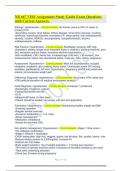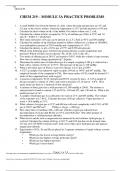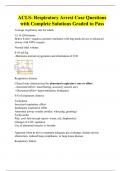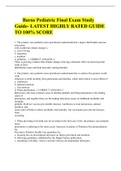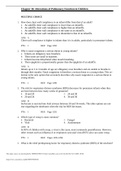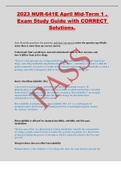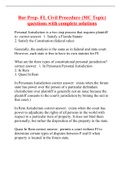Econometrics ECS3706
Assignment 02 Solutions
Due date: 13 September 2024
Compiled by Ranga:
Whatsapp: zero six one eight four four one three eight seven
1) Explain why econometricians must know and understand the classical linear regression
assumptions (4).
Understanding the classical linear regression assumptions is crucial for econometricians
because it enables them to diagnose and correct potential issues in their models, ensuring
that the results are both valid and reliable. When these assumptions are violated, the
estimates generated by a linear regression model may be biased, inconsistent, or inefficient.
For example, if heteroscedasticity is present, standard errors may be incorrect, leading to
misleading confidence intervals and hypothesis tests. By recognizing such violations,
econometricians can apply alternative estimation techniques, such as robust standard errors
or instrumental variables, to obtain more accurate results. This diagnostic ability is
essential for refining the model to better reflect the underlying relationships in the data,
thus improving the overall quality of the econometric analysis.
Moreover, a deep understanding of these assumptions is necessary for interpreting the
results of a regression model accurately. Awareness of the assumptions guides
econometricians in assessing whether the model’s estimates can be trusted and whether the
conclusions drawn are valid. This understanding also plays a critical role in developing
robust models that are tailored to the specific characteristics of the data and the research
question at hand. By carefully considering the assumptions during the model-building
process, econometricians can ensure that the chosen model is appropriate, thereby
, enhancing the credibility and applicability of the findings. Ultimately, these assumptions
provide the foundation for reliable econometric analysis, ensuring that the estimates
derived from a linear regression model are meaningful and useful for decision-making and
policy formulation.
2) The Central Limit Theorem (CLT) plays a pivotal role in statistical hypothesis testing by
establishing that, regardless of the underlying distribution of the population, the sampling
distribution of the sample mean will approximate a normal distribution as the sample size
becomes large. This property allows statisticians to make inferences about population
parameters using the normal distribution, even when the original data is not normally
distributed. In hypothesis testing, the CLT justifies the use of z-tests and t-tests, enabling
the calculation of p-values and confidence intervals. This makes it possible to assess the
likelihood of observing the sample data under the null hypothesis, thereby guiding
decisions on whether to reject or fail to reject the null hypothesis.
3)
a) Lagged GDP (GDPt−1): The coefficient for lagged GDP is expected to be positive. This
reflects the idea that past GDP influences current GDP, as economies tend to have
momentum. A higher GDP in the previous period indicates a stronger economy, which
likely continues to perform well in the current period.
Capital Investment (CI): The coefficient for capital investment is expected to be positive.
Capital investment boosts productivity and economic growth, leading to an increase in
GDP.
Labour (L): The coefficient for labor is also expected to be positive. An increase in the
labor force generally contributes to higher production and economic output, which should
positively influence GDP.
Assignment 02 Solutions
Due date: 13 September 2024
Compiled by Ranga:
Whatsapp: zero six one eight four four one three eight seven
1) Explain why econometricians must know and understand the classical linear regression
assumptions (4).
Understanding the classical linear regression assumptions is crucial for econometricians
because it enables them to diagnose and correct potential issues in their models, ensuring
that the results are both valid and reliable. When these assumptions are violated, the
estimates generated by a linear regression model may be biased, inconsistent, or inefficient.
For example, if heteroscedasticity is present, standard errors may be incorrect, leading to
misleading confidence intervals and hypothesis tests. By recognizing such violations,
econometricians can apply alternative estimation techniques, such as robust standard errors
or instrumental variables, to obtain more accurate results. This diagnostic ability is
essential for refining the model to better reflect the underlying relationships in the data,
thus improving the overall quality of the econometric analysis.
Moreover, a deep understanding of these assumptions is necessary for interpreting the
results of a regression model accurately. Awareness of the assumptions guides
econometricians in assessing whether the model’s estimates can be trusted and whether the
conclusions drawn are valid. This understanding also plays a critical role in developing
robust models that are tailored to the specific characteristics of the data and the research
question at hand. By carefully considering the assumptions during the model-building
process, econometricians can ensure that the chosen model is appropriate, thereby
, enhancing the credibility and applicability of the findings. Ultimately, these assumptions
provide the foundation for reliable econometric analysis, ensuring that the estimates
derived from a linear regression model are meaningful and useful for decision-making and
policy formulation.
2) The Central Limit Theorem (CLT) plays a pivotal role in statistical hypothesis testing by
establishing that, regardless of the underlying distribution of the population, the sampling
distribution of the sample mean will approximate a normal distribution as the sample size
becomes large. This property allows statisticians to make inferences about population
parameters using the normal distribution, even when the original data is not normally
distributed. In hypothesis testing, the CLT justifies the use of z-tests and t-tests, enabling
the calculation of p-values and confidence intervals. This makes it possible to assess the
likelihood of observing the sample data under the null hypothesis, thereby guiding
decisions on whether to reject or fail to reject the null hypothesis.
3)
a) Lagged GDP (GDPt−1): The coefficient for lagged GDP is expected to be positive. This
reflects the idea that past GDP influences current GDP, as economies tend to have
momentum. A higher GDP in the previous period indicates a stronger economy, which
likely continues to perform well in the current period.
Capital Investment (CI): The coefficient for capital investment is expected to be positive.
Capital investment boosts productivity and economic growth, leading to an increase in
GDP.
Labour (L): The coefficient for labor is also expected to be positive. An increase in the
labor force generally contributes to higher production and economic output, which should
positively influence GDP.

